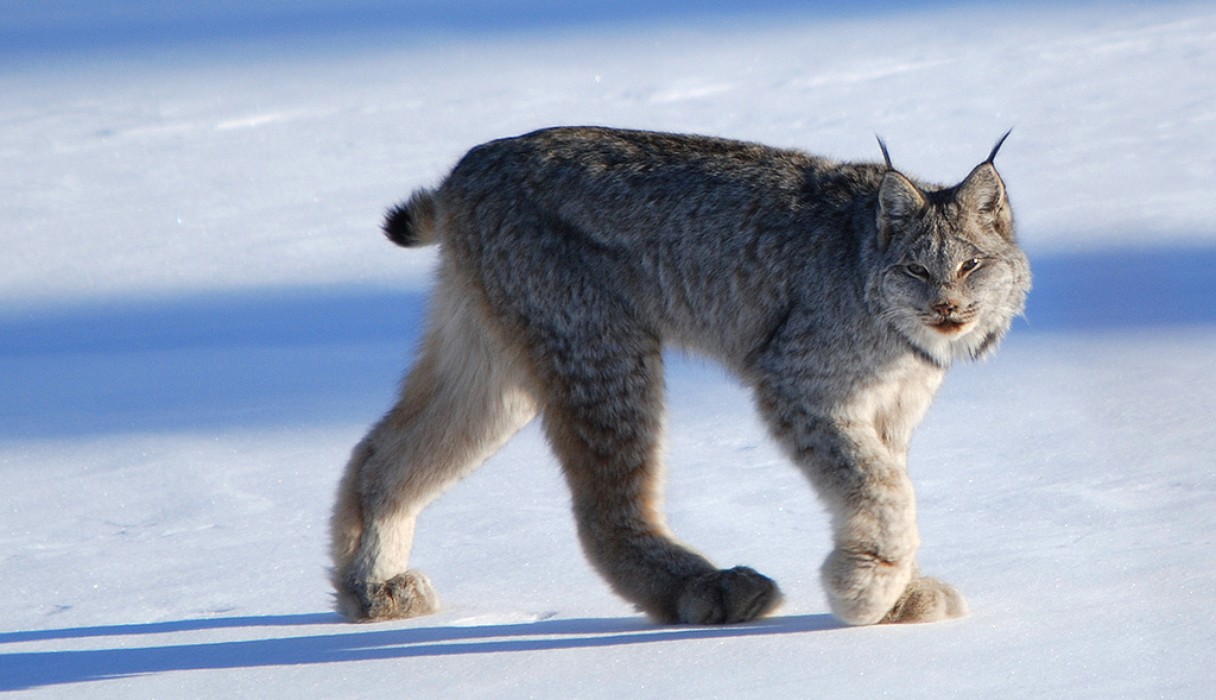A full-grown Canada lynx is two dozen pounds of
furred muscle, razor claws and ears with little tufts — not your average
tabby, in other words.
 Don’t call this young Canada lynx a “kitty-cat.” (Flickr: U. S. Fish and Wildlife Service - Northeast Region CC BY-SA 2.0)
Don’t call this young Canada lynx a “kitty-cat.” (Flickr: U. S. Fish and Wildlife Service - Northeast Region CC BY-SA 2.0)
But they’re getting a helping hand from the U.S. Fish and Wildlife Service, which designated 24.9 million acres of forest in Idaho, Maine, Minnesota, Montana, Washington and Wyoming as protected areas for these cats on Thursday.
 (Flickr: Jeremiah John McBride CC BY-SA 2.0)
(Flickr: Jeremiah John McBride CC BY-SA 2.0)
 (Flickr: Keith Williams CC BY-SA 2.0)
(Flickr: Keith Williams CC BY-SA 2.0)
The
protected habitat was born out of five years of court challenges
between snowmobile associations and conservation groups. Although most
of the conservationists are pleased that parts of the lynxes’ range will
be protected from activities that cause “destruction or adverse modification of critical habitat,” such as forging new snowmobile trails, some point out that a key part of the lynx habitat will not be protected.
“The high-quality lynx habitat in the Kettle River Range deserves federal protections,” says Dave Werntz, Conservation Northwest’s science and conservation director. “Lynx were once abundant in northeast Washington but have not recovered from historic over-trapping, breaking the link in the network of lynx populations deemed essential for recovery.”
 (Flickr: Jeremiah John McBride CC BY-SA 2.0)
(Flickr: Jeremiah John McBride CC BY-SA 2.0)
Jim Zelenak, a USFWS wildlife biologist, tells the Associated Press that the designation emphasizes where lynx can survive long-term.
The omitted habitat is “marginal” or “just too far away from the main
population," Zelenak says to the AP. "We need to stick to the biology of
the animals."
It’s difficult to quantify the Canada lynx population in the U.S., which fluctuates with both prey availability (they eat mainly snowshoe hares) and cats prowling between Canada and the States.
 Don’t call this young Canada lynx a “kitty-cat.” (Flickr: U. S. Fish and Wildlife Service - Northeast Region CC BY-SA 2.0)
Don’t call this young Canada lynx a “kitty-cat.” (Flickr: U. S. Fish and Wildlife Service - Northeast Region CC BY-SA 2.0)
These impressive hunters, listed as “threatened” under the U.S. Endangered Species Act, are at risk chiefly due to habitat loss. As climate change shrinks the cats’ range, loss of genetic diversity is becoming problematic for parts of the lynx population.
 (Flickr: Jeremiah John McBride CC BY-SA 2.0)
(Flickr: Jeremiah John McBride CC BY-SA 2.0)
“I’m
glad such a large area has been protected for my favorite big cat, the
Canada lynx,” Noah Greenwald, of the Center for Biological Diversity, in
a statement. “These unique cats face a broad array of threats, including snowmobiles, trapping, development and now climate change.
They need every acre of critical habitat that was designated, and more,
if they’re going to avoid extinction in the United States.”
 (Flickr: Keith Williams CC BY-SA 2.0)
(Flickr: Keith Williams CC BY-SA 2.0)“The high-quality lynx habitat in the Kettle River Range deserves federal protections,” says Dave Werntz, Conservation Northwest’s science and conservation director. “Lynx were once abundant in northeast Washington but have not recovered from historic over-trapping, breaking the link in the network of lynx populations deemed essential for recovery.”
 (Flickr: Jeremiah John McBride CC BY-SA 2.0)
(Flickr: Jeremiah John McBride CC BY-SA 2.0)It’s difficult to quantify the Canada lynx population in the U.S., which fluctuates with both prey availability (they eat mainly snowshoe hares) and cats prowling between Canada and the States.
source

No comments:
Post a Comment